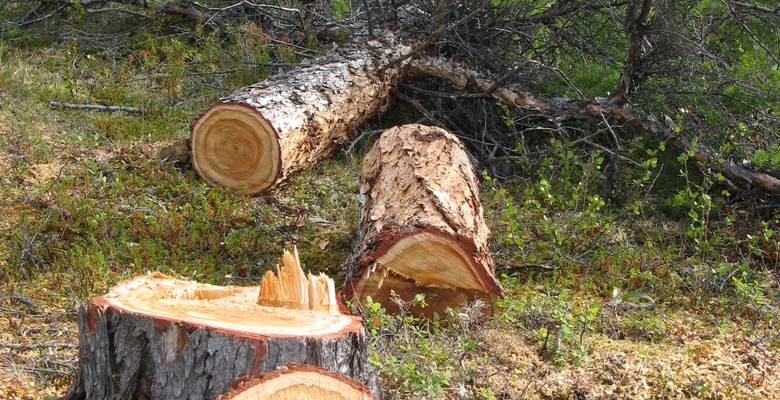
Dendroclimatic monitoring
Since early 1990s Russia has been building a uniform state system of ecological monitoring. It includes a section of dendrochronological and dendroclimatic monitoring, which represents “an information system of tracking, evaluation and forecasting the changes in annual tree growth and the factors that drive such tree growth”.
This section of monitoring constantly receives new data and by now has accumulated unique spatially-distributed dendroclimatic data (about 500 tree ring chronologies and data from 350 meteorological stations), which present a dynamic description of the condition of forest ecosystems at almost the entire territory of the Russian Federation that are affected the environmental factors.
All the research in this area is based on the collection, processing and analysis of the original data, specifically of wood samples of various species of wood for a diverse range of forest ecosystems of the planet. Depending on the goals and tasks of the research a specific habitat and specific number of model trees (usually no less than 15) are selected. No trees are damaged during the research as the collection of material (wood core samples) is done by the most tree-sparing method with the help of a Swedish drill with a diameter ranging from 5 to 10 mm. The collected material is then processed, digitized and turned into time series called tree-ring chronologies. Researchers only have to properly utilize the actual data. For example, the data can be used to compile a forecast of the future of the ecosystem or solve the opposite task – to restore the climatic conditions of tree growth based on the tree-ring chronologies.
From Wolf number to global ecosystem
Already in the ancient times people knew how to tell the age of a tree by the rings on its cross-section. The width of the rings could prompt in which years the tree grew faster, which means that in that year climatic conditions were more favorable for the tree. But the science of dendrochronology started specifically with modeling. In late XIX century Andrew Douglass, an American astronomer, discovered that the width of tree rings correlated with the 11-year cycles of solar activity (Wolf numbers) and compiled a forecast of droughts in southwestern USA, which was successfully used by local farmers.
Since then the area of application of dendrochronology has significantly expanded - from research in the area of plant physiology to global ecology. The approach to dendroclimatic modeling has changed as well. There are many special approaches, and one of them is the so-called imitation modeling. Such modeling is better suited for the imitation of real processes, but it is also more complicated. Globally, there are currently about ten imitation models of tree ring growth.
Simple and effective
In late 1980s scientists from Krasnoyarsk Vaganov and Shashkin proposed an imitation model as applied to modeling the growth of tree rings based on daily climatic data. The model was so simple that some Russian and foreign scientists were initially skeptical about it.
But the Vaganov-Shashkin model (VS-model) has proved its effectiveness by adequately modeling the growth of trees on the basis of climatic data for a very diverse habitats of the Northern Hemisphere: the South-Western part of the USA, Northern Africa (Tunisia), the Pyrenees (Spain), the Alps (Switzerland and France), the Tibetan Plato and Inner Mongolia (China) and vast territories of Siberia. The results obtained on the basis of that model were published in the Nature, Science, PNAS, Global Change Biology and other highly cited publications.
Today the model is going through a renaissance. The main block of the model contains 27 parameters closely linked both with the functioning with the woody plant itself as well as the conditions of its development. The main difficulty has always been in the adequate evaluation of the readings of those parameters, which can significantly vary depending on what territory we are talking about. For example, Scotch pine (Pinus sylvestris) in the Pyrenees grows in quite different conditions then the same pine that grows in the permafrost in central Yakutia. Such differences affect the model parameters: it is necessary to select the parameters so that they don’t contradict the physiology of the growth of woody plants as well as the direct nature observations obtain in the habitats we are interested in.
From the formal (mathematical) standpoint finding the optimal balance in the 27-parameter space is not an easy task. Special algorithms and powerful computers have hard time coping with that sort of tasks. But there was a solution found for the Vaganov-Shashkin model. Our group has simplified the selection of such parameters as we have developed visual semi-automatic procedures of parameterization (VS-oscilloscope).
In 2015 an improved VS-model was successfully tested in practice when on the request of the Chinese Academy of Scientists we helped our Chinese colleagues evaluate the possible reaction of woody plants on the Chinese territory based on the forecast climatic changes.
At present time, we are testing the automatic parameterization of the model based on three parallel processes: direct parameterization of the VS-model (evolutionary optimization algorithm), parameterization via a VS-metamodel (via multilayer perceptron) and additional training of the VS-metamodel in order to decrease the norm of discrepancy between the modeled growth graphs obtained in the first two parameterization attempts.
Such system is virtually an artificial intellect system, which allows in automatic mode analyzing the condition of forest ecosystems on the vast territory of Eurasia taking into account all possible climatic scenarios in the medium and long term.
Prof. Vladimir Shishov, PhD in Technical Sciences, Head of Department of Mathematical Methods and Information Technologies, Siberian Federal University, Krasnoyarsk







